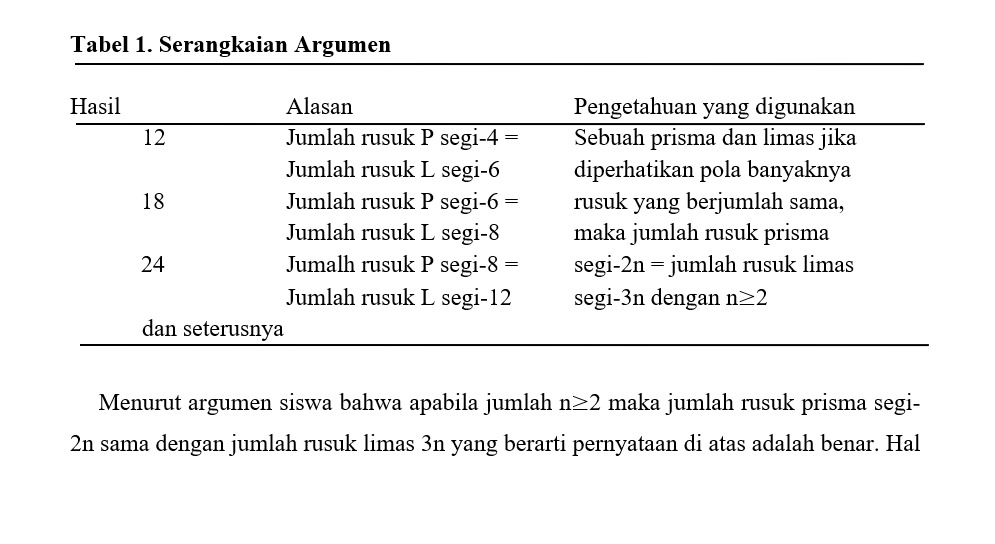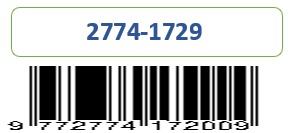Keterampilan Berpikir Kritis Matematis Siswa Ditinjau dari Gaya Kognitif Pada Materi Bangun Ruang
Abstract
Penelitian ini awalnya didasarkan pada minat peneliti dalam kasus yang ditemukan pada siswa ketika menyelesaikan persoalan matematika yang diberikan dalam bentuk keterampilan berpikir terhadap suatu masalah. Penelitian ini bertujuan untuk mengeksplorasi pola berpikir siswa untuk menggambarkan keterampilan berpikir kritis siswa saat mereka memberikan solusi penyelesaian secara kritis terhadap sebuah masalah matematika. Penelitian ini adalah penelitian kualitatif dalam studi kasus yang melibatkan satu siswa sebagai subjek penelitian. Temuan menunjukkan bahwa (1) kemampuan siswa menyelesaikan masalah dengan strategi yang tepat sesuai dengan pengetahuan awalnya dengan gaya kognitif yang dimiliki oleh siswa tersebut; (2) pengalaman pribadi dari pengetahuan awal yang disimpan dalam memori jangka panjang; (3) aktivitas kebenaran dalam bernalar.
Downloads
References
Arlius, Y. (2022). Team-Based Learning : Its Concept , Implementation and Challenges. November, 432–437.
Choy, S. C. (2012). Reflective Thinking and Teaching Practices: a Precursor for Incorporating Critical Thinking Into the Classroom? Online Submission, 5(1), 167–182.
Chukwuyenum, A. N. (2013). Impact of Critical thinking on Performance in Mathematics among Senior Secondary School Students in Lagos State. IOSR Journal of Research & Method in Education (IOSRJRME), 3(5), 18–25. https://doi.org/10.9790/7388-0351825
Creswell, J. W., & Creswell, J. D. (2018). Mixed Methods Procedures. In Research Defign: Qualitative, Quantitative, and Mixed M ethods Approaches.
Dudduan, C., Nirat, & Sumalee, C. (2015). Development of learning management model based on constructivist theory and reasoning strategies for enhancing the critical thinking of secondary students. Educational Research and Reviews, 10(16), 2324–2330. https://doi.org/10.5897/err2015.2193
Facione, P. A. (2016). Proceedings of the World Molecular Imaging Congress 2016, New York, New York, September 7-10, 2016: General Abstracts. Molecular Imaging and Biology, 18(S2), 1–1278. https://doi.org/10.1007/s11307-016-1031-0
Kloppers, M., & Grosser, M. (2014). The Critical Thinking Dispositions of Prospective Mathematics Teachers at a South African University: New Directions for Teacher Training. International Journal of Educational Sciences, 7(3), 413–427. https://doi.org/10.1080/09751122.2014.11890203
Sellah, M. L., Jacinta, D. K., & Helen, P. M. (2017). Analysis of Student-Teacher Cognitive Styles Interaction: An Approach to Understanding Learner Performance. Journal of Education and Practice, 8(14), 10–20.
Septantiningtyas, N., & Subaida, S. (2023). Gaya Kognitif Field Independent Sebagai Ikhtiyar Kontrol Fokus Siswa dalam Pembelajaran. Attadrib: Jurnal Pendidikan Guru Madrasah Ibtidaiyah, 6(1), 48–56. https://doi.org/10.54069/attadrib.v6i1.378
Sternberg. (2016). Critical thinking: Its nature, measurement, and improvement. National Inst. Of Education, 11(1), 217–232. https://pdfs.semanticscholar.org/80a7/c7d4a98987590751df4b1bd9adf747fd7aaa.pdf





















.png)
